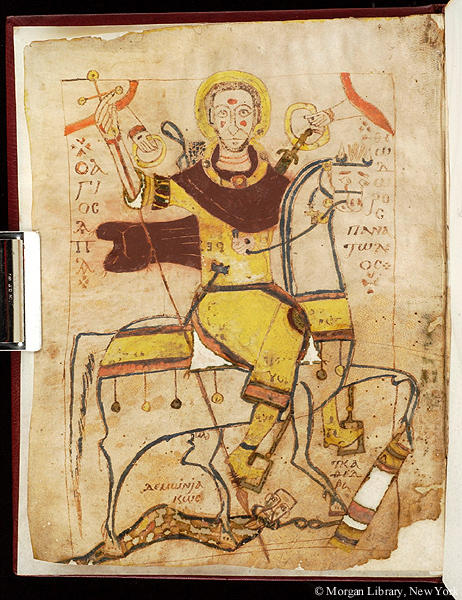St. Theodore, Coptic, after Dec. 31, 867AD.from the Martyrdom of Saints Theodore the Anatolian (the Oriental), Leontius the Arab, and Panigerus the Persian. Egypt |
St. Theodore, Coptic, after Dec. 31, 867AD.from the Martyrdom of Saints Theodore the Anatolian (the Oriental), Leontius the Arab, and Panigerus the Persian. Egypt |
Description of MS M.613 fol. 1v
Theodore Tyro, name inscribed, nimbed, wearing jeweled necklace and inscribed garment, armed with, or pierced by, sword, mounted on bridled horse wearing caparison (?), with stirrups, holding reins in left hand and with cross-surmounted lance in right hand transfixing prostrate demon, labelled, in form of serpent with human head, chained to object labelled "cathedra", and trampled by the horse; the saint flanked above by two wreaths or possibly crowns, each held by Hand of God, emerging from arc of heaven.
School: Egypt, Fayum, Touton.
Language: Coptic, the Sahidic dialect, and Greek
Pierpont Morgan Library. MS M.0613, fol. 001v
Referenced as figure 145 in The military technology of classical Islam by D Nicolle
145. Manuscript from Fayyum, St. Theodore. 9th Century AD, Coptic, Pierpont Morgan Lib. Ms. 613, f. 1v, New York (Ler C).
An extract from Arms and Armour of the Warrior Saints: Tradition and Innovation in Byzantine Iconography (843-1261) edited by Piotr Grotowski
COSTUME AND ARMOUR OF THE WARRIOR SAINTS 307
The warrior saints in a provincial guise (in a kabadion)
Besides the military saints in armour and in the courtly uniforms of the protospatharioi there is a group of depictions originating from the southern and eastern borderlands of the Empire which differ in terms of dress. Belonging to this group is an equestrian image of St Theodore of Anatolia (fig. 77) in a Synaxarion from St Michael’s monastery in Hamula near Fayyum (Pierpont Morgan Library. New York, no. M 613, fol. 1v).676 The horseman is depicted in a long, yellow (gold?) short-sleeved tunic that might be identified as a kabadion and a purple cape. He does not, however, wear a cuirass or a shield. The presence of the maniakion on his neck may suggest stylisation of his image as an officer. This motif is, however, quite common in Coptic art; it is worn for example by St Menas in a manuscript in the John Rylands Library in Manchester (Ms. Coptic 33), and by the archangel Michael on a miniature in a manuscript originally from Fayyum, now in the Pierpont Morgan Library, New York.677 The first of these is of special interest: Menas is shown on horseback with a cloak thrown over his shoulders and a long ankle-length scale-armour corselet, which is fastened by a waist-belt. The cut is deceptively similar to the kabadion of the ‘Eastern’ St Theodore, which may indicate that it is a combat variant of the garment. Similar doubts do not arise in relation to another representation of mounted saints wearing the kabadion: this shows two bearded saints (Theodore and George) on an eleventh- or twelfth-century stone relief currently in the Benaki Museum, Athens, found in Pontic Amaseia, and probably from one of the churches there. The two saints are arranged symmetrically, and use their lances to spear a recumbent figure who has a sword in his
676 See L’art Copte. no. 52 (=Walter 2001, 186, fig. 12).
677 See Walter 2001. 185-6, figs. 11, 13; Walter 2003a, 186, fig. 56.
308
right hand (fig. 84).678 The surface of their kabadia (which open at the front), their windblown capes and the kaftan-like garment of the fallen ruler are ornamented with simple rosettes. The cubic style of the relief, a long way from the traditions of ancient art, indicates the provincial character of the local workshop, which probably operated in Amaseia itself.
Depictions of warrior saints in long tunics that might he interpreted as a kabadion, also became popular in Nubian art.679 The appearance of this iconographic type in territories that were subject to or bordered the Muslim world suggests that the costume of the military saints was influenced here by the iconography and customs connected with Arabic and Persian culture.680 Light cavalry, whose basic weapon was the bow, still formed the core strength of Arab armies, and later of Turkish ones in the thirteenth century. This is reflected in the iconography of the Islamic states,681 while a relief in the church of the White Virgin (Spitakavor Astvatsatsin) in Yeghegnadzor in Armenia (1321), showing Prince Amir Hasan II hunting deer on horseback (fig. 85)682 proves that the type of the rider in a kabadion remained in use in Christian art from provincial circles until the late Middle Ages.